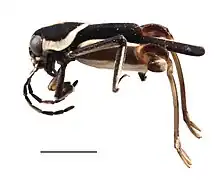| Tridactyloidea | |
|---|---|
 | |
| Ripipteryx mopana | |
| Scientific classification | |
| Domain: | Eukaryota |
| Kingdom: | Animalia |
| Phylum: | Arthropoda |
| Class: | Insecta |
| Order: | Orthoptera |
| Suborder: | Caelifera |
| Infraorder: | Tridactylidea |
| Superfamily: | Tridactyloidea Brullé, 1835 |
| Families | |
Tridactyloidea[1] is a superfamily in the order Orthoptera. The insects are sometimes known as pygmy mole crickets but they are Caelifera and not members of the mole cricket suborder Ensifera, unlike the true mole crickets, the Gryllotalpidae. It is composed of three families that contain a total of about 50 species. Insects in this superfamily can be 4 to 9 millimeters in length and generally have short antennae and long wings. They live along the banks of bodies of water in tropical areas and are good swimmers and jumpers. Fossils of this subfamily have been found in Siberian deposits dating back to the Cretaceous.[2][3]
Families
According to the Orthoptera Species File there are three families:
- Cylindrachetidae Giglio-Tos, 1914: "sandgropers" of Australia, Papua New Guinea and South America
- Ripipterygidae Ander, 1939: "mud crickets" of central and South America
- Tridactylidae Brullé, 1835: "pygmy mole crickets" in many (especially tropical) areas.
References
- ↑ Brullé GA (1835) In Audouin & Brullé: Histoire naturelle des insectes 9 [1] (5):1-225 [225–416 in 1836]
- ↑ Prokhorov, Aleksandr Mikhailovich (1979). Great Soviet Encyclopedia (in Russian) (3rd ed.). Macmillan Publishers.
- ↑ Otte, Daniel (1997). Tetrigoidea and Tridactyloidea. The Orthopterists' Society and the Academy of Natural Sciences of Philadelphia. p. 261.
This article is issued from Wikipedia. The text is licensed under Creative Commons - Attribution - Sharealike. Additional terms may apply for the media files.